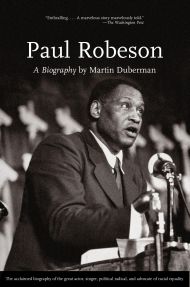
Martin Duberman depicts the talent and travails of the immensely gifted and politically bold Paul Robeson.
Paul Robeson was one of the most gifted Americans ever.
An All-American football player and valedictorian at Rutgers University. A graduate of Columbia Law School. A gifted singer and actor. And a man of unswerving political courage and conviction.
Yet for years Robseon was far more appreciated overseas than at home.
He endured years of not being able to travel outside of the United States because of his outspoken pro-Communist beliefs, and was compared, and found to be wanting, by many Americans after his 1949 appearance with baseball pioneer Jackie Robinson before the House Un-America Activities Committee.
History professor Martin Duberman tells the story of Robeson’s life, remarkable talents and price he paid for his political beliefs in Paul Robeson: A Biography.
At 550 pages, the book is chockful of detail that begins with Robeson’s birth in 1898 at Princeton, New Jersey and marches through in chapters that generally cover two years until his death in 1976.
A fascinating life is depicted in the interim.
Duberman chronicles Robeson’s dazzling gifts, his charismatic personality and his gradually emerging political radicalism. Through his own personal experiences and his exposure to life abroad, Robeson eventually came to the conclusion that black America’s best hope for meaningful change lay in Communism as practiced by the Soviet Union.
Robeson held tenaciously to these views, visiting the country, repeatedly praising its absence of discrimation, and refusing to relinquish his beliefs even after Nikita Khrushchev came to power following Joseph Stalin’s death and exposed some of the previous regime’s horrific abuses.
Duberman shows how Robeson paid a heavy price for his beliefs and public statements of them. For years he was forbidden to travel outside the United States and he also lost the support he had received from many white, and some black, Americans who were uncomfortable with, or disapproved of, his views.
A poignant note in the book comes during the 60s, when black militants during the civil rights movement advocate many of the same positions that Robeson did in his book, Here I Stand, but the combination of his absence from the public scene and the book’s paltry circulation meant that many younger activists did not know about Robeson’s work and contribution.
The book is more than a political biography, though, and Robeson’s willingness to bear the consequences of his political commitments is just one part of this rich work.
Duberman spends extensive time talking about Robeson’s multi-faceted and wildly successful international career as a film star and concert artist. He recounts vividly the dizzying array of characters that run through Robeson’s life, from his tenacious wife Essie to supporters like Carl Van Vechten to intellectual luminaries like W.E.B. DuBois and C.L.R. James. In addition to conveying Robeson’s remarkable gifts and charisma, Duberman also effectively recounts the exciting and changing times in which he lived.
Although clearly impressed with his subject’s gifts, versatility, charisma and courage, Duberman has not written a book of hagiography. He does not hesitate to show Robeson’s insecurities about his performances, the uneven reviews he receives at times, his self-absorption and the string of affairs that begin early in his marriage to Essie and continue almost without interruption throughout his life (If Duberman does not give Robeson a pass by saying that he did not hold to a belief in monogamy, his moral judgment is certainly a light one in this area of his life).
These elements of the book give Duberman’s account credibility. His willingness to show unsavory and unattractive sides of Robeson paint a more human portrait of the man and, ultimately, emphasize the unusual nature of his talents.
The final decade of Robeson’s life were filled with sadness. The body of the once physically dominant athlete withered, the once massive crowds thinned and their appreciation, so loud diminished to a whisper.
Tended to largely by his son, Paul Jr., and daughter-in-law, Robeson died quietly in late January, 1976.
The response to his death mirrored that in his life. The white press, after hassling him for decades, tipped its hat to Robeson even as it ignored its role in his persecution and the nation’s inability to incorporate a black men whose views did not bend. The black press paid more homage to Robeson; Duberman also includes a poem by a black prisoner in Marion, Illinois:
PAUL ROBESON
They knocked the leaves
From his limbs,
The bark
From his
Tree
But his roots
were
so deep
That they are
a part of me.
Written after Robeson’s death, the poem captures his strength, his tenacity in the face of adversity and his enduring impact on the black community.
Duberman writes in the introduction that “That a man so deeply loved all over the world could evoke in his own country such an outpouring of fear and anger may be the central tragedy-America’s tragedy-of Paul Robeson’s story.”
In the early days of the Obama presidency, and more than three decades after his passing, Robeson and his life may be due for reconsideration and, perhaps, renewed appreciation. Duberman’s biography gives us plenty of material for that project.
